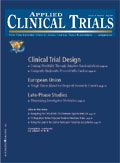A Consensus for Accreditation
Applied Clinical Trials
A growing number of sponsors and regulators are recognizing that accredited organizations are more likely to be compliant.
Is it true that there is not enough demand for a rigorous participant protection oversight program as PHRP (Partnership for Human Research Protection) suggested in September 2005 when it announced that it was going out of business with 10 organizations accredited? That is not what we found.

Marjorie Speers, PhD
AAHRPP (Association for the Accreditation of Human Research Protection Programs) has seen demand by research organizations and sponsors grow. Hundreds of organizations have come to AAHRPP to put their participant protection programs to the test by submitting to an objective assessment of whether they have integrated safeguards at every level of their research operations.
Accreditation is an outside measure of the quality and reliability of a research organization's program for participant protection, and sponsors have found that the quality also shows in the research itself. Sponsors and regulators know organizations that are rigorous in the application of their participant protections are equally committed to solid, credible, reliable research.
According to Marianne Vanderwel, associate director, corporate pharmaceutical regulatory monitoring, Pfizer Canada, "Accreditation helps industry by improving regulatory compliance through promoting a culture of responsible conduct of research by competent investigators."
Seal of approval with benefits
Since AAHRPP's founding we have accredited 35 organizations, including 102 research entities. Another 360 are in the process of accreditation. We expect that within the next two to three years all the major research intensive organizations will have completed the accreditation process and that many other research organizations will be volunteering their participant protection programs for close scrutiny, including clinical research organizations, government agencies, hospitals, independent IRBs, research sites, and universities.
Accreditation builds trust and serves as a badge of honor for a research organization. Its numerous tangible advantages not only benefit the institution, but also the research participants, sponsors, and government regulators.
Going through the process significantly improves an organization's participant safeguards. Organizations carefully examine their programs and measure them against objective national standards that go beyond the federal requirements. Even the best programs find areas they can improve. The accreditation process helps ensure written policies and procedures clearly explain the human research protection program.
Accredited organizations also discover organizational and budgetary benefits. As a result of the process, a number of organizations have streamlined their operations, improved collaboration and staff utilization, and saved on liability insurance through Lloyd's of London, which offers a 5% premium discount to AAHRPP-accredited research organizations in recognition of their reduced risk.
A growing number of sponsors and regulators are recognizing that accredited organizations are more likely to be compliant. This decreases the workload for sponsors, who must demonstrate their commitment to participant protections, and regulators.
Growing preference
While the FDA and OHRP have spoken in favor of accreditation, an important signal of government support is the lead many of the federal agencies have taken in seeking accreditation of their intramural research programs, including a mandatory requirement for accreditation by the VA.
Some suggest only the leaders in the research community are stepping up while others won't submit their programs unless regulators and sponsors demand it. Although such a demand would certainly accelerate the process, the movement is already well underway. More organizations will seek accreditation because it is the smart thing to do and because they see that sponsors are increasingly making accredited institutions their first choice. When they demonstrate that their protection programs meet the test, the sponsors will have a pool of reliable research organizations from which to choose.
Sponsors can expand that pool of superiorly qualified research organizations faster if they all make clear their preference for accreditation.
Marjorie Speers, PhD, executive director, Association for the Accreditation of Human Research Protection Programs, Inc.
FDA Fast Tracks Johnson & Johnson’s Nipocalimab for Fetal Neonatal Alloimmune Thrombocytopenia
March 27th 2024Johnson & Johnson is moving forward with a pair of Phase III trials of nipocalimab to reduce the risk of fetal neonatal alloimmune thrombocytopenia in alloimmunized pregnant patients.
